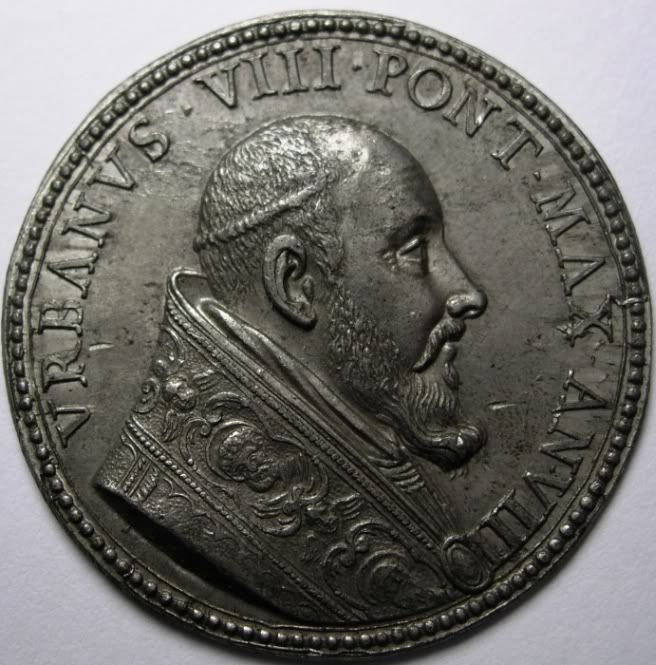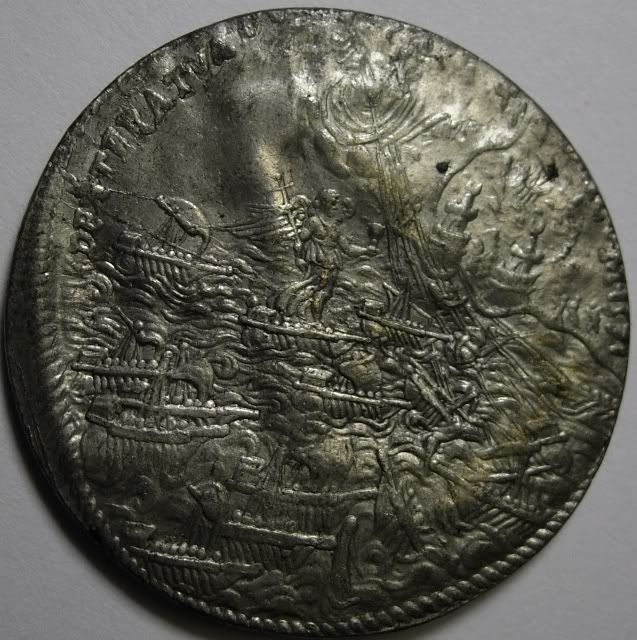Info/help on this Papal Medal
 JRocco
Posts: 14,277 ✭✭✭✭✭
JRocco
Posts: 14,277 ✭✭✭✭✭
Hey guys,
I picked up this papal medal because I was intrigued by it. It looks to be a gilt-pewter, or gilt-tin medal with most of the gilding worn off.
It is a very thin piece that shows reverse rippling due to the heavy strong obverse strike. I am assuming this is a restike on pewter, but I am not sure.
It is an Urban VIII papal medal and the reverse depicts the Battle of Lepanto Against the Turks. It is dated 1571
Is this a mule striking? I am not sure this reverse was originally paired with Urban VIII. If not does anyone know the Spink number for this piece?
Any info is appreciated.


I picked up this papal medal because I was intrigued by it. It looks to be a gilt-pewter, or gilt-tin medal with most of the gilding worn off.
It is a very thin piece that shows reverse rippling due to the heavy strong obverse strike. I am assuming this is a restike on pewter, but I am not sure.
It is an Urban VIII papal medal and the reverse depicts the Battle of Lepanto Against the Turks. It is dated 1571
Is this a mule striking? I am not sure this reverse was originally paired with Urban VIII. If not does anyone know the Spink number for this piece?
Any info is appreciated.


Some coins are just plain "Interesting"
0
Comments
Conder Token Gallery https://photos.google.com/share/AF1QipMCiunai6NjOxoo3zREkCsAnNm4vONzieO3u7tHyhm8peZmRD_A0MXmnWT2dzJ-nw?key=Rlo2YklUSWtEY1NWc3BfVm90ZEUwU25jLUZueG9n
Virtus Collection - Renaissance and Baroque Medals
Interesting.
FOR SALE Items
This is in fact a mule striking. The original, as mentioned was on a Pope Pius V piece. Here is a better image of the reverse as seen on a gilt-bronze Pope Pius V piece.
And here is an image I was able to find of an original Pope Pius V depiction of the medal in bronze.
Notice on this piece the die crack forming to the left of the sail on the top ship on the left at approx K10.
This same die crack can be seen on my piece leading to the point that this was the same die used on my piece above.
It has been suggested that the reverse die may have been heat damaged and put aside only to be later pressed back into service
to strike a few more pieces.
Fascinating.
<< <i>It has been suggested that the reverse die may have been heat damaged and put aside only to be later pressed back into service to strike a few more pieces. >>
Definitely not. The die still exists in the museum of the Rome Mint and does not show any damage like that (the die crack is of course present). I doubt this was struck.
Virtus Collection - Renaissance and Baroque Medals
Thanks for the info. Do you think this might be an electrotype or possibly a spark erosion die?
It is referred to as a white metal. I am thinking along the lines of pewter or tin. Would this be likely?
<< <i>Hey Joe,
Thanks for the info. Do you think this might be an electrotype or possibly a spark erosion die?
It is referred to as a white metal. I am thinking along the lines of pewter or tin. Would this be likely? >>
I'm not sure, as I myself am not the most knowledgeable about all of the manufacturing processes. Something such as electrotyping might be possible, though I noticed in the other thread you mentioned (and posted a pic) that the edge did not contain a seam. Some flaws are also present on the obverse, such as around the 'X' in 'MAX', which I do not think should be present from striking.
Virtus Collection - Renaissance and Baroque Medals
Here is a close-up of the area you mentioned. There is a fold of metal that appears to be present on
some areas of the obverse (not reverse) which I tend to think can occur from a casting. But I too
am not knowledgeable in all areas of medal production.
I do not have any leaning or preference to the type of manufacture of this piece other than a desire to understand it.